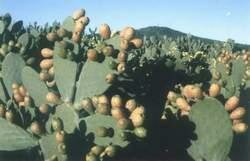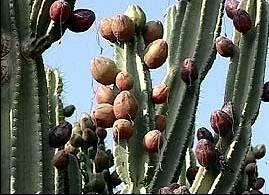 |
 |
|


Don't get pricked ...
Prickly pear
The bad group are those trees and plants which have been imported into South Africa and which simply do not know how to behave in our environment. Also known as aliens.
Check out the Department of Agriculture list of aliens.
Link: Department of Agriculture
 |
Prickly pear cactus (Opuntia ficus-indica)
This is one of four introduced cactus species which are problem invader spies in South Africa, costing millions of rands annually to control. The other species are Opuntia aurantiaca (Jointed cactus), Opuntia imbricate (Imbricate cactus) and Opuntia rosea (Rosea cactus).
This is one of four introduced cactus species which are problem invader spies in South Africa, costing millions of rands annually to control. The other species are Opuntia aurantiaca (Jointed cactus), Opuntia imbricate (Imbricate cactus) and Opuntia rosea (Rosea cactus).
All these cacti were introduced into South Africa as attractive garden subjects, but escaped and were highly successful because this country lacks their natural pests and dieses. All four have been declared noxious weeds by legislation, which means that they must not be cultivated and must be destroyed wherever they occur.
The spineless variety will revert to the spined variety through the natural hybridization process during pollination and seed dispersal.
Opuntia ficus-indica
A branching shrub with flattened fleshy leaf pads, 30-60cm long with variable amounts of thorns. Flowers produced during November, producing a yellow flower which develops into the well known prickly pear fruit. Prickly pear is a rapid invader of natural vegetation, which is replaces, forming an impenetrable barrier. Since 1883 various mechanical and chemical methods of control have been attempted and in 1932 a campaign of biological control was introduced. The prickly pear cochineal beetle (Dactylopius opuntiae) was introduced in the Cape and caused the collapse of the population in that area and other parts of the country.
Prickly pear cactus are found in the Magaliesberg. The seeds are extremely fertile and the birds and baboons relish the ?‘pears?’. No doubt the birds and baboons visit the area during the fruiting season, returning to the safety of the talus slopes after feeding, where the seeds are deposited with their droppings.
 |
Queen of the night cactus (Cereus peruvianus)
Description:A tall multistemmed succulent, grey to blue green in colour. Stems erect, 100-200mm in diameter, with six to nine deep grooves, the ridges between bearing star-like tufts of 5-10 black to brown spines, each 10-30mm long. Flowers white, large and showy, up to 150mm long, narrowed into a tube at the base, opening at night.
Fruit: orange-yellow, almost hairless, roughly spherical, about 40mm in diameter.
Seeds: many, black and about 2mm wide.
Distribution: Transvaal, especially in the bushveld north of Pretoria.
Notes: Widely grown as a barrier plant or as an ornamental in gardens. The fruit is eaten by birds and monkeys and the seeds are dispersed in this way. Infestations are usually found under trees as a consequence, but do also occur in open spaces. Broken or chopped branches often root and form new plants. They should therefore be buried deeply or burnt. There is a registered herbicide for use against this species. Cereus is sometimes confused with the indigenous Euphorbia ingens (Candelabra euphorbia or naboom) but being a cactus does not exude milky latex when cut, as the euphorbias do. Cereus is a native of South America.
Major infestations have developed in the Hartbeespoort Dam area of the Magaliesberg.

 |
 |




